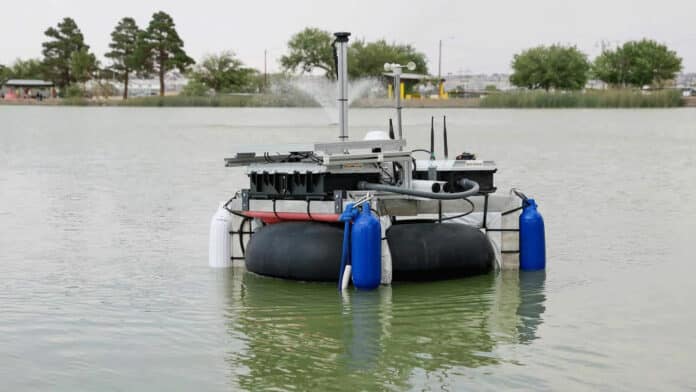Bathymetric surveys play a fundamental role in the analysis of geomorphologic features of water bodies like oceans, rivers, lakes, and reservoirs, with extensive applications in fluvial geomorphology, hydrologic sciences, and oceanic sciences. The surveys allow scientists to measure the depth and map the underwater features of a water body.
Underwater maps can be used to understand how much water is in the reservoir, for example. It also can be used to detect hidden objects that are underwater. But the survey process usually takes a crew of individuals to complete. It could sometimes be dangerous for the crew because weather conditions can complicate the work.
Now, researchers at The University of Texas at El Paso (UTEP) have developed a fully autonomous boat that can carry out bathymetric surveys. The team hopes the self-driving boat can help simplify the survey process as well as assist with reconnaissance missions.
“There are lots of reasons scientists carry out bathymetric surveys,” said Laura Alvarez, Ph.D., lead author of the study. “If you want to work in water-related studies, you need to know the shape and landscape of bodies of water. For example, you might want to map a reservoir to learn about water supply for electrical demand or a river to learn about river evolution or flow patterns.”
Alvarez, who specializes in unmanned systems for earth science, started developing the boat several years ago but needed help tweaking and perfecting the system. So, she teamed up with electrical engineering master’s student Fernando Sotelo, who spent an entire year refining the boat, making it fully autonomous and responsive to potential environmental issues like wind speed and temperature flux.
The robotic boat features a 3-foot-by-3-foot circular aluminum watercraft that rests on a thick black inner tube. It operates with four thrusters, allowing it to travel up to 5 feet per second and easily rotate 360 degrees. The boat is powered by a solar panel and lithium battery that allow it to last up to four hours at sea – covering an area of up to 472,400 square feet.
The self-driving boat also includes a multibeam echosounder – a sonar system – that emits sound waves from the bottom of the boat. This leads to water depth being calculated by the time it takes for the sound wave to water to hit the seafloor and return to the sonar system. The sound that returns to the device can help detect the type of material on the seafloor.
With all the incorporated sensors and controls, this unmanned surface vehicle (USV) can make self-governing decisions like returning to base if the wind is too strong for sailing and improve its safety. In addition, the boat can reach hard-to-access areas and help the crew avoid dangerous situations.
To show proof of concept, the team successfully created 2D and 3D maps of portions of Ascarate Lake in El Paso, Texas, and Grindstone Lake in Ruidoso, New Mexico. Alvarez further plans to use the self-driving boat for the first time this summer to study the Rio Grande River’s flow and depth.
“My goal was to make the boat state-of-the-art, and I think I did that. Of course, there’s always room to improve,” said Sotelo, who worked on the boat for his master’s thesis. “But the system works, and for now, I hope it can make it easier for scientists like Dr. Alvarez to conduct their research.”
Journal reference:
- Fernando Sotelo-Torres, Laura V. Alvarez, and Robert C. Roberts. An Unmanned Surface Vehicle (USV): Development of an Autonomous Boat with a Sensor Integration System for Bathymetric Surveys. Sensors, 2023; DOI: 10.3390/s23094420
